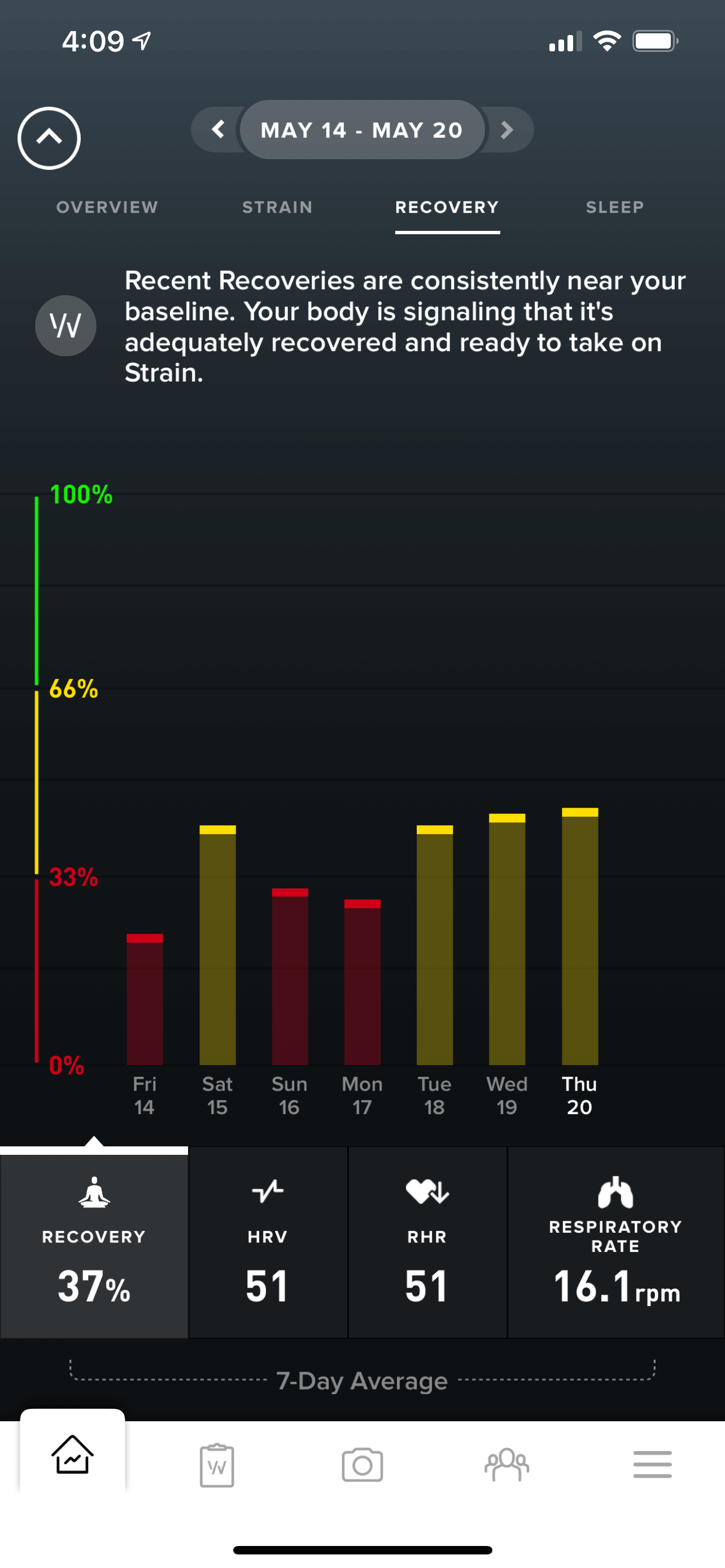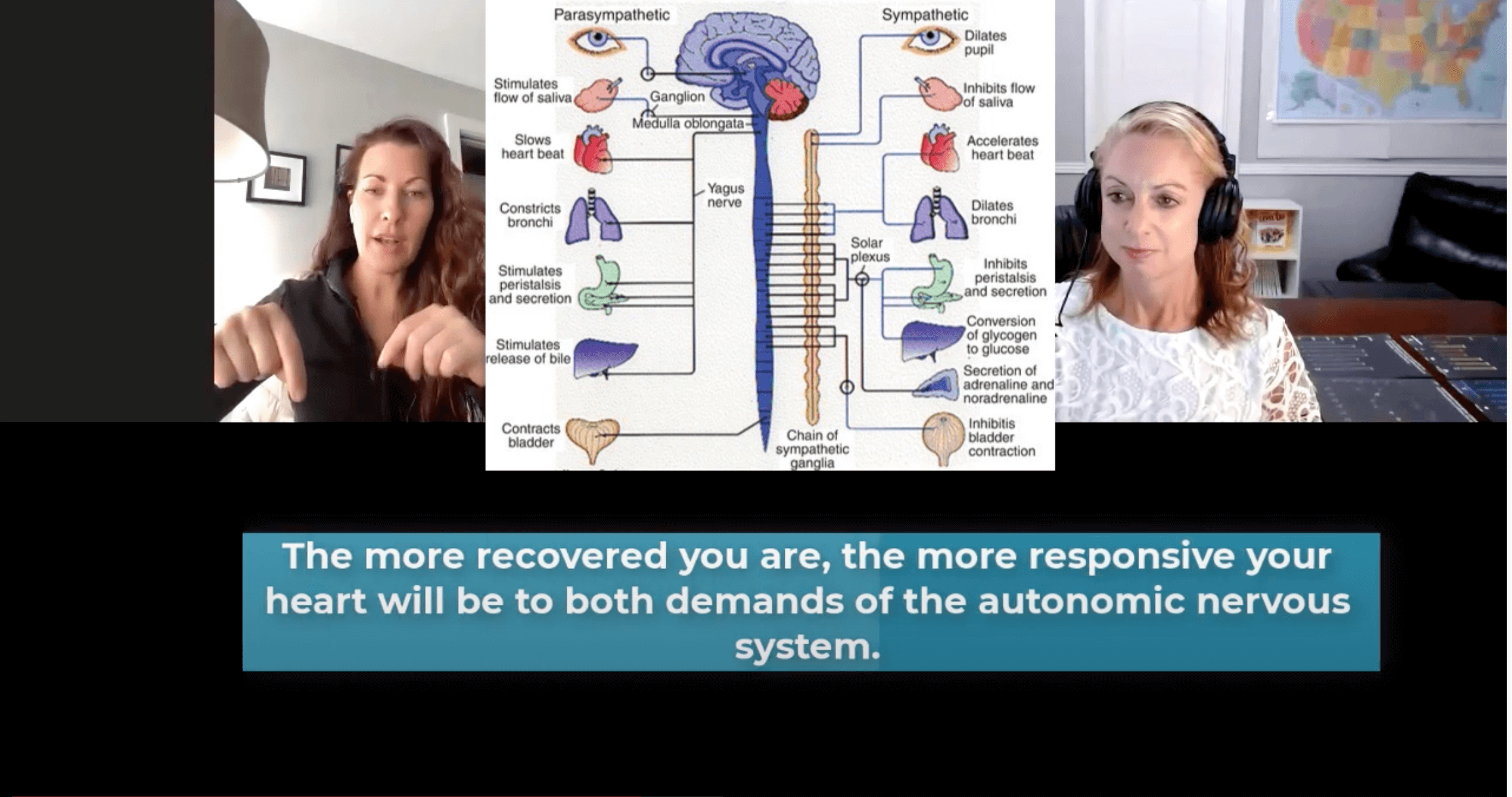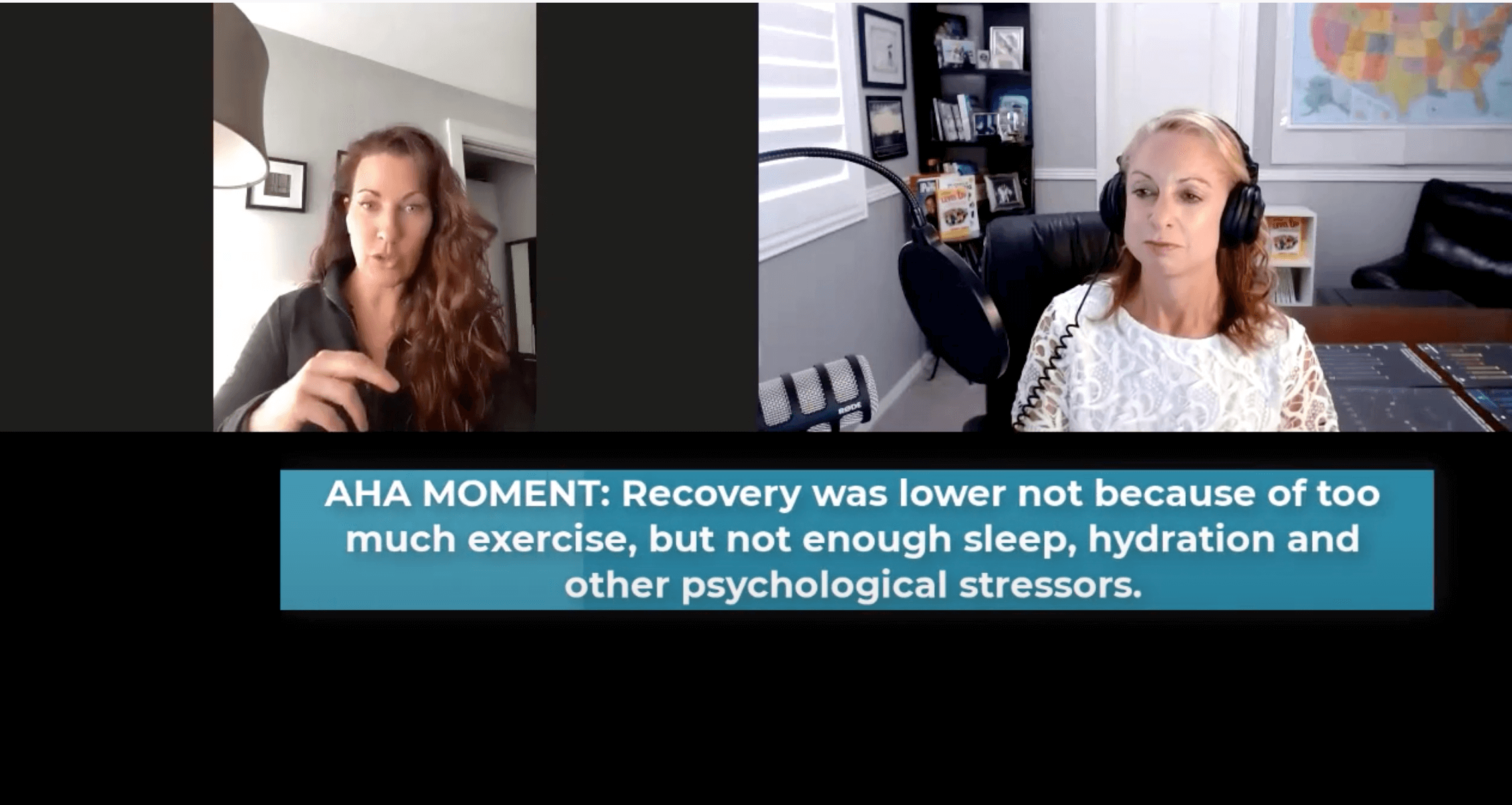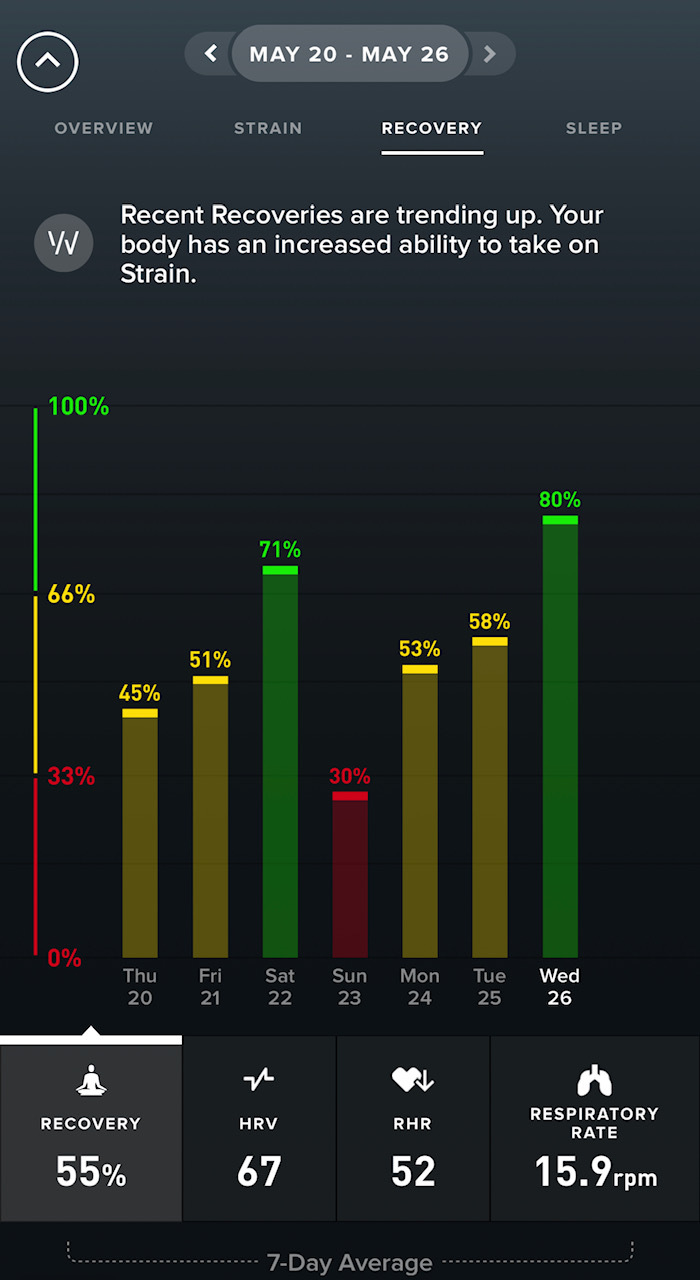Welcome back to the Neuroscience Meets Social and Emotional Learning Podcast, for Brain Fact Friday and episode #135 on my biggest AHA moment from EPISODE #134 with Kristen Holmes, the VP of Performance Science of WHOOP[i], a wearable personal fitness and health coach that measures sleep, strain, and recovery.
To see the images in the show notes, and Andrea's Data, click here.
In Today’s Brain Fact Friday You Will Learn:
✔︎ How the wearable health tracker WHOOP measures recovery.
✔︎ Why this data is useful for athletes, and humans in general, for mitigating physical, mental, and emotional stress.
✔︎ Strategies to improve recovery and decrease physical and psychological stress.
✔︎ See Andrea’s data and how she achieved her highest recovery rates using these strategies.
✔︎ How you can measure your own recovery to improve performance and resiliency.
Welcome back, I'm Andrea Samadi, a former educator who has been fascinated with understanding the science behind high performance strategies in schools, sports, and the workplace for the past 20 years. If you have been listening to our podcast, you will know that we’ve uncovered that if we want to improve our social and emotional skills, and experience success in our work and personal lives, it all begins with an understanding of our brain.
The purpose of this podcast is to bring the most current brain research to you, so you can make it applicable in your life whether you are a teacher in the classroom, or using these ideas to improve productivity and results in your workplace. As I am researching and learning new ideas, I’m also implementing them myself, and making connections to past speakers, so that we can all benefit from the research that is emerging in this new field of educational neuroscience.
If you listened to EPISODE #134[ii] with Kristen Holmes, the VP of Performance Science with WHOOP whose Ph.D. work is in multilevel interactions of stress and circadian behavior[iii] or the impact of light on sleep optimization, you’ll know that I first came across Kristen while researching Heart Rate Variability for EPISODE #125[iv] where I started to see how important this one measurement was for tracking health, recovery, and resilience which is crucial to brain health and performance. After listening to the WHOOP podcast, with Founder Will Ahmed, I joined the community so that I could measure my HRV that I learned from Neurohacker Collective[v] is “the most important biomarker”[vi] --a measure that captures what’s going on in a cell at any given moment that can serve as an early warning system for your health. As someone who has been working hard to make use of every second of the day, I thought, “I’ve got to know this number if I want to be operating at my highest capacity.” No one wants to intentionally leave anything on the table to chance or luck and staying on top of these metrics is a guaranteed way to take the guesswork out of human performance.
Which leads us to this week’s Brain Fact Friday with a powerful AHA Moment I had during the interview with Kristen Holmes. After a month of measuring my data, and looking at the daily recovery score, I adjusted my behavior based on that number, and thought that recovery was based on the idea that I had to let my body recover physically after those days that I had high strain or exercised harder than usual. Even without measuring this data, we have a pretty good idea of days that we need to rest, based on how we feel. I looked at the recovery score each morning, and it was never showing GREEN which would be 66%-100% recovered. My recovery score (that you can see a snapshot of in the show notes) was either yellow (recovering) or RED (not ready to take on strain) that I thought meant give your body more rest to prevent injury. I even had a chart that told me that multiple days above my optimal strain targets (that averaged a score of 16) will promote fitness gains, but to dedicate time to rest if I continue this behavior, so I told Kristen that I actually stopped some of my workouts.

My thinking was close, but not exactly accurate, and since I’m new to measuring this data, was missing some key information that I would learn from Kristen. What would you think recovery means? When you are tired mentally and physically, how do you restore yourself? There is a way to use this data to improve future performance, that goes beyond what I think we would usually think about, and this was the biggest AHA Moment I had with my interview with Kristen Holmes, and also from listening to the podcast WHOOP did with Patrick Mahomes[vii], a world-class athlete who quantified the strain of his NFL season using the WHOOP device. I thought it was crazy to see that he averaged over 20 for strain on game days and learned to change his behavior (both mentally and physically) to recover after these high intensity days.
Bringing us to this week’s BRAIN FACT FRIDAY:
DID YOU KNOW that recovery is “a measurement of physiological stress (how our body responds to our environment, or the demands we are putting on our physical body with our workouts), and psychological stress (manifested from our Autonomic Nervous System)? Patrick Mahomes talked about the mental aspect of his training in depth, going into detail of how he uses visualization and the importance of his mental mindset, in addition to working on the fundamentals, for his success.
Kristen Holmes reminded me that recovery is based on “how well you are coping with external stress”[viii] and the WHOOP device measures this score based on 4 measurements which each are important, but the first two gave me the insight I needed to better understand how we can measure and improve recovery.
- HRV: heart rate variability or the distance measured between our heartbeats. “The higher your HRV (the more variability you have between heartbeats), the more your nervous system is in tune with your environment, and the better you’ll perform. A lot of things affect your HRV, with stress as the most common factor”[ix] and HRV will be low when you are exercising at a high capacity and really pushing it and goes back up higher when you allow your body the rest and recovery needed for repair. HRV levels can tend to be lower when you are tired and go higher when you get enough sleep. Activity level, stress, illness, hydration, alcohol consumption, nutrition and how tired you are can all impact your HRV levels.
- Sleep: how much you needed vs what you actually are getting, and how much sleep you spend at each sleep stage.
- Resting heart rate: that’s an indicator of physical fitness and heart function.
- Respiratory Rate: (that usually doesn’t usually change from day to day, but is something to pay attention to, if this measurement does change.”

Kristen went on to explain that recovery is “a measurement of physiological stress (how our body responds to our environment, or the demands we are putting on our physical body with our workouts), and psychological stress (manifested from our Autonomic Nervous System).

And that the “more recovered you are, the more responsive your heart will be to both demands of the ANS—and the less recovered, the less responsive you will be.” If your recovery score is low, and you are trying to run from a tiger (as an example) you won’t be as responsive to the stress, or if your recovery score is low, and you are hoping to perform at work or school, you will not have the reservoirs of fuel that you could have, if you had done things differently, and were operating from a highly recovered score.

Since the WHOOP recovery score correlates to your HRV score, for those who don’t use the WHOOP device can still use their HRV score (you can measure this for FREE using an app on your phone)[x] and remember that “the more variability you have between heart beats (or the higher your HRV score) the more capable you are of adapting to external stress (relationship stress, financial stress, or the stress our body goes under with the foods we are putting into it etc.).” (Kristen Holmes)
So here was my AHA Moment: Recovery was lower not because of too much exercise, but not enough sleep, hydration, and other physical stressors. What strategies do you have to mitigate your daily stress? What is your relationship with light, and do you know how to use light to help your circadian rhythm? Can you improve your sleep quantity and quality?

Some great questions to think about with this AHA Moment, making me reflect on some strategies from past episodes that can help improve the psychological stressors to improve recovery, and then I was speaking to a colleague from Israel, named Shlomit, who was sharing with me the turmoil her country has been experiencing with the missile attacks earlier this month.[xi] She mentioned to me the psychological and mental conflict these attacks have had on many people in her area, disrupting their daily life and bringing uncertainty, fear and stress. Their peace and safety were taken away in a heartbeat, and she realized this was something she had taken for granted for so long. She didn’t ever worry about not having safety and security in her own home and suddenly she is sharing a bomb shelter with another family and not even sure she can finish her shower, for fear of evacuation. Much like the freedom that many people around the world lost during the Pandemic, and the upheaval this time has caused families worldwide. During this conversation, Shlomit asked me if I knew the meaning of the word “Shalom” and although I had heard this word often, especially during Passover, I couldn’t give her the meaning. She told me it meant “peace” and was also used to say hello or goodbye, and that her name, Shlomit, was the feminine version of the word peace and that although there was much fear, turmoil, stress and uncertainty in her world, she knew she had to savor the peace in her life, and never take this freedom for granted again the future.
My AHA moment with Kristen, on the importance of managing psychological stress, paired with my conversation with Shlomit, reminded me to look back at the bonus episode we did with Dr. Carolyn Leaf[xii], on Cleaning Up Your Mental Mess[xiii]: 5 Simple, Scientifically Proven Steps to Reduce Anxiety and Toxic Thinking for our strategies to improve psychological well-being, that will improve our recovery score.
You can download her APP Neurocycle[xiv] (formerly called the Switch App) that walks you through the 5-step process that I cover in my review of her book,[xv] based on 38 years of research, on how to change your brain (which is neuroplasticity in action) and get rid of toxic thoughts through self-awareness, journaling and reflecting. These 5 steps do take some time, but if you want to clean up your mental mess and close the gaps you might have with energy you are wasting on toxic thinking, it’s important to do this work.
STEP 1: Gather Awareness (of what’s bothering you). We’ve all heard of the importance of knowing our emotions, or when we name what’s bothering us, we can tame it[iv]. What about those worries that we name, and they don’t go away? These worries or fears really can impact our mental health, and we have seen with our recovery score, can impact our health and performance. If you have something on your mind, the first thing you can do is to take out a journal, and write out some of the worries that are taking space in your mind.
I’ve also heard this being called a CRAP Board, where you write out all of your conflicts, resistances, anxieties and problems. Once you have gotten them out of your head, and see them on paper, it’s easier to look at them and think “am I worrying about something that has not happened yet?” If so, get it out of your head, and stop worrying about things that may or may not happen in the future. Schlomit reminded me to savor the peace and safety in your day, as it can be quickly taken away, like hers was.
STEP 2: Reflect and Analyze: Answer, Ask and Discuss Some Questions to Find the Root Cause of Your Emotions or What’s Bothering You.
This is how we pull thoughts from our non-conscious mind to our conscious mind, where it becomes weaker. It’s no longer suppressed but acknowledged. Use your mind to ask yourself questions, and it will be interesting to see what comes up. This process takes time, reflection and daily effort. Our emotions are unique signals to learn how to cope with challenges, but over time, they will damage our brain with consistent worry. See if you can get a new perspective on what you are worrying about. Is there anything positive you can gather from your insight?
STEP 3: Write out what you discover from step 2. Begin to capture what’s bothering you and see if you can come up with root causes, or why you think this worry is on your mind. Learn to write in pictures, add color, shapes. Learn how to write in a metacog formula.[v]
STEP 4: Recheck and Edit What You Have Written Down. Re-read what you have written and see what comes up. Can you add more to your answer to help make more sense of it? Dig deeper, look for patterns, triggers and keep looking for the root cause of the problem that’s occupying your mind.
STEP 5: Practice and Apply Through Active Reach. Look at what you have written and see if you can come up with an action statement to practice what you have learned from your introspection. You will read out your daily Aha Moment 7x a day to remind yourself what you are re-shaping, or make it easy, and let the app or your phone send you a reminder.
Example: I am worrying about xyz because I am afraid of xyz…but this hasn’t happened, and most likely will not happen, so this worry is wasting my time. If it happens one day, I will deal with this problem then, but not wasting the mental energy worrying about something that I cannot control. I can control my reaction to my worry.
So in my journal, I wrote out my worries like branches on a tree, and the trunk she says is the perspective of the thought. I begin to look at my worries from a different angle or perspective. Right here you should notice a shift in energy about the problem. I started to see mine differently here looking at it from a distance. Then the roots of the tree are the origin story, or root of why I am worrying about this problem, which is what we want to uncover. This activity will give you an incredible amount of self-awareness.
The next day, I had my highest recovery day in the past month:

If you have something like this on your mind, I highly suggest taking the time to upload the app on your phone, grab a journal and begin the work to eliminate and clean up your mental mess.
You could also learn more about Resonance Frequency Breathing[xvi], that Kristen Holmes suggested as “the best way to improve HRV, sleep, recovery and reduce anxiety.” (Kristen Holmes, WHOOP). This type of breathing is when the frequency of our breath matches the frequency of our heart, bringing coherence, giving us a stronger ANS (Autonomic NS) and allows us to control our stress response better, and become resilient to physical, mental and emotional stressors.
To review this week’s Brain Fact:
DID YOU KNOW that recovery is “a measurement of physiological stress (how our body responds to our environment, or the demands we are putting on our physical body with our workouts), and psychological stress (manifested from our Autonomic Nervous System)? It’s important that we have strategies in place to mitigate our physiological and psychological stress.
Once you have these strategies in place, (like Dr. Leaf’s 5 steps to Cleaning Up Our Mental Mess), Meditation, or what Kristen suggested as the best way to improve HRV, sleep, recovery and reduce anxiety, with Resonance Frequency Breathing, it’s as simple of implementing them, measuring how your recovery has improved and then knowing when to add more strain. The key is to not just guess with these numbers.
If you have a passion to improve your performance and life and are human, I highly recommend looking at the WHOOP device to learn more about your recovery score. Episode #134 with Kristen Holmes received so much feedback and interest from high level performers, past podcast guests, athletes, Google executives, people in the health and wellness industry, from around the world, letting me know how much they love this wearable health and wellness tracker.
I look forward to seeing you next week with another case study, this one is a fascinating story of Lois Letchford, whose son failed first grade, could only read 10 words, had no strengths, and was given a low IQ. Lois used the principles from Dr. Immordino-Yang, from interview #100, and her son was able to defy the odds, and graduated from Oxford University with his Ph.D. in 2018. I can’t wait to share her story with you, but until then, have a good weekend. See you next week.
RESOURCES:
Recovery Tips from Leading WHOOP Members
https://www.whoop.com/thelocker/recovery-tips-from-leading-whoop-users/
REFERENCES:
[ii] Neuroscience Meets Social and Emotional Learning Podcast EPISODE #134 with Kristen Holmes, VP of Performance Science of WHOOP.com on “Unlocking a Better You: Measuring Sleep, Recovery and Strain” https://andreasamadi.podbean.com/e/kristen-holmes-from-whoopcom-on-unlocking-a-better-you-measuring-sleep-recovery-and-strain/
[iii] Let there be circadian light Feb.20, 2020 University of Washington Health Sciences https://www.sciencedaily.com/releases/2020/02/200220141731.htm
[iv] Neuroscience Meets Social and Emotional Learning Podcast EPISODE #125 “What is Heart Rate Variability and Why is it Important for Tracking Health, Recovery and Resilience” https://andreasamadi.podbean.com/e/what-is-hrv-and-why-is-it-important-for-tracking-health-recovery-and-resilience-with-andrea-samadi/
[vi] Biomarkers https://www.niehs.nih.gov/health/topics/science/biomarkers/index.cfm
[vii] Patrick Mahomes’ WHOOP Data: Quantifying the Strain of an NFL Season by Mark Van Deusen https://www.whoop.com/thelocker/patrick-mahomes-heart-rate-strain-data/?utm_source=members&utm_campaign=the-locker&utm_medium=email&utm_content=patrick-mahomes-heart-rate-strain-data&_ke=eyJrbF9jb21wYW55X2lkIjogIlBBQm5XSyIsICJrbF9lbWFpbCI6ICJhbmRyZWFAYWNoaWV2ZWl0MzYwLmNvbSJ9
[viii] Neuroscience Meets Social and Emotional Learning Podcast EPISODE #134 with Kristen Holmes, VP of Performance Science of WHOOP.com on “Unlocking a Better You: Measuring Sleep, Recovery and Strain” https://andreasamadi.podbean.com/e/kristen-holmes-from-whoopcom-on-unlocking-a-better-you-measuring-sleep-recovery-and-strain/
[ix] IBID
[xi] https://www.bbc.com/news/world-middle-east-57094737
[xii] Neuroscience Meets Social and Emotional Learning Podcast BONUS EPISODE with Dr. Carolyn Leaf on “Cleaning Up Your Mental Mess: 5 Simple, Scientifically Proven Steps to Reduce Anxiety and Toxic Thinking” https://andreasamadi.podbean.com/e/worldrenownedneuroscientistdr-caroline-leaf-oncleaningup-your-mentalmess5-simplescientifically-proven-stepsto-reduceanxiety-and-toxic-thinking/
[xiii] Cleaning Up Your Mental Mess: 5 Simple, Scientifically Proven Steps to Reduce Anxiety, Stress and Toxic Thinking by Dr. Caroline Leaf AVAILABLE FOR PRE-ORDER NOW (March 2, 2021) https://www.amazon.com/Cleaning-Your-Mental-Mess-Scientifically/dp/0801093457
[xiv]https://theswitch.app/?_ke=eyJrbF9jb21wYW55X2lkIjogIktxZ0g5ZCIsICJrbF9lbWFpbCI6ICJhbmRyZWEuc2FtYWRpQGNveC5uZXQifQ%3D%3D
[xv] Neuroscience Meets Social and Emotional Learning Podcast EPISODE #106 Review of Neuroscientist and Best-Selling Author Dr. Carolyn Leaf’s “Cleaning Up Your Mental Mess” https://andreasamadi.podbean.com/e/book-and-app-review-of-neuroscientist-and-best-selling-author-dr-caroline-leafs-cleaning-up-your-mental-mess-coming-march-2-20201/
[xvi] Resonance Frequency Breathing Published on YouTube Sept. 25, 2020 https://www.youtube.com/watch?v=EIi1Tc5i8s4&t=694s
No comments yet. Be the first to say something!